Abstract
Landslides are the nation’s hidden disaster, significantly increasing economic loss and social disruption. Unfortunately, limited information is available about the depth and extent of landslides. Therefore, in order to identify landslide-prone zones in advance, a well-planned landslide susceptibility mapping (LSM) approach is needed. The present study evaluates the efficacy of an MCDA-based model (analytical hierarchy process (AHP)) and determines the most accurate approach for detecting landslide-prone zones in one part of Darjeeling, India. LSM is prepared using remote sensing thematic layers such as slope, rainfall earthquake, lineament density, drainage density, geology, geomorphology, aspect, land use and land cover (LULC), and soil. The result obtained is classified into four classes, i.e., very high (11.68%), high (26.18%), moderate (48.87%), and low (13.27%) landslide susceptibility. It is observed that an entire 37.86% of the area is in a high to very high susceptibility zone. The efficiency of the LSM was validated with the help of the receiver operating characteristics (ROC) curve, which demonstrate an accuracy of 96.8%, and the success rate curve showed an accuracy of 81.3%, both of which are very satisfactory results. Thus, the proposed framework will help natural disaster experts to reduce land vulnerability, as well as aid in future development.
1. Introduction
Disastrous natural hazards such as landslides have brought enormous casualties and economic losses in the past. In hilly areas, the essential requirement for ensuring people’s safety is the identification of high-risk landslide-prone zones where development should not be conducted, and where soil stabilization works should be conducted. Nearly 12.60% of landslides have occurred in the Indian Himalayan region, and all areas can be detected as being landslide-prone. In developing countries such as India, various terrain hills are experiencing increasing population density and rapid infrastructural development, which may increase the vulnerability to potential landslides and thus socio-economic losses. The study area is situated in the Himalayan region, where landslides are a common occurrence due to the area’s topography and geology. The region encompasses several major cities, including Darjeeling, Ghum, Rangbull, and Sonada, which attract a large number of tourists daily. The population in the area is dense, and significant land-use changes have taken place over the years, further exacerbating the risk of landslides. By conducting landslide susceptibility mapping in these areas, it is possible to identify high-risk zones and inform land-use planning decisions to mitigate the impact of landslides on the local population and infrastructure. Quantitative and qualitative approaches are used to classify landslide susceptibility mapping (LSM) [1,2,3,4]. To prevent these losses and improve the efficiency of LSM, new methods and different hybrid models are introduced every day by researchers [5,6,7,8,9,10]. Machine learning approaches have also been introduced in this field in recent years [11,12,13,14]. Different ensemble methods and hybrid models are also used to assess and identify LSM [8,15]. The overall incidences of landslides are increasing, and the factors causing the landslides are the growth of urbanization, and development in landslide-prone areas.
Changing climate patterns, increased local rainfall, etc., are the reasons behind constant changes in landslide-prone zones [16,17]. Most losses would be avoided by identifying the problematic areas, land deforestation, etc. Hence, recognizing the existing and potentially unstable slopes is most significant task. Due to mass changes in urbanization and growing awareness of its socio-economic impact in the hilly region, significant attention is focused on the study of landslides [18]. Hence, LSM of any terrain helps to classify areas into different classes concerning the degree of potential hazards. Recently, various GIS tools have helped to identify conditioning factors that may influence an area’s vulnerability to landslides. Rainfall and earthquakes significantly trigger landslides due to their external and temporal aspects [19]. For effective disaster management and future improvement, developers and engineers use landslide susceptibility maps [12,20,21]. The identification of risk areas, coupled with a proper landslide assessment plan, can help disaster management planners and developers to minimize accidents and losses. Many parts of the Himalayas are not physically accessible but geospatially can be accessible everywhere, so assessing landslides using the geospatial technique is easy [22,23]. Geospatial and geotechnical modeling has been used by different researchers in the last few years for landslide susceptibility and hazard assessment using different parameters [24,25,26]. Land-use change is a major contributor to landslides, causing significant environmental and socioeconomic impacts [27]. In order to achieve sustainability goals and reduce landslide risks, understanding the spatiotemporal evolution and influencing factors of land-use change is essential [28,29,30]. Land-use change can create slope instability, increasing the susceptibility of an area to landslides. Deforestation, urbanization, and mining are examples of land-use changes that can alter soil properties and destabilize slopes [31]. The impacts of land-use change on landslide susceptibility are complex and influenced by factors such as topography, geology, climate, land-use policies, and population growth [26]. A comprehensive approach is necessary to achieve sustainability goals, which includes considering the impacts of land-use change on landslide susceptibility. Sustainable land-use planning can play a critical role in reducing landslide risks by preserving natural ecosystems, restoring degraded land, and promoting low-impact development practices [32,33]. Accurate landslide susceptibility mapping is crucial for identifying at-risk areas and making informed land-use planning decisions. With advances in remote sensing and geographic information systems (GIS) technology, sophisticated landslide susceptibility models have been developed to capture the complex interactions between land-use change and landslide susceptibility [23,34,35]. Understanding the spatiotemporal evolution and influencing factors of land-use change is the key to achieving sustainability goals and mitigating landslide risks. Sustainable land-use planning and effective landslide susceptibility mapping can contribute to promoting a low-carbon, resilient future. The LSM has multiple uses, identifying unstable areas in advance, disallowing new construction in hazard-prone areas, relief operations, etc. An analytical hierarchy process (AHP)-based method has been attempted in the study area to prepare LSM due to its simplifying method of assigning ranks and weights [21,29,36]. Different natural hazards such as floods, gully erosion, earthquakes, and liquification can also be classified through AHP methodology [37,38,39]. It is a method to derive ratio scales from paired comparisons from the principal eigenvectors [29].
The study of landslide susceptibility mapping in Darjeeling is due to a combination of various factors in the area. A high-resolution DEM is used for the delineation of various thematic layers. With a high population density, significant land-use changes, and challenging topography, the study region provides an interesting case study for analyzing the complex interactions between topography, land use, and population growth contributing to landslide risk in the Himalayan region. This study has the potential to provide valuable insights for informing land-use planning decisions and reducing the impact of landslides on local communities. The current study focuses on identifying the possible landslide areas for stabilizing the citizens’ safety and the area’s future development. To aid in the development of more accurate and reliable landslide susceptibility models that can be applied to other regions with similar challenges, the AHP method is adopted to recognize the landslide prone areas. The published result can be utilized by West Bengal tourism for future development and controlled habitation in hazard-prone areas.
2. Materials and Methods
2.1. Study Area
The study region is located in the Darjeeling district of West Bengal, India, in the Eastern Himalayan mountain environment (Figure 1). The area is situated in latitudes 88°171′ E to 88°343′ E, 26°933′ N to 27°082′ N and encompasses around 256 Km2 of the region. The maximum elevation in this region is 2600 m from mean sea level (MSL). The most dreaded and widespread landslide event in the Darjeeling Himalayas occurred in 1968, triggering many shallow and deep-seated landslides [40]. It is believed that many prominent and large landslides in the Darjeeling hills are still active today [41]. Thus, the region requires a systematic study for LSM. The landslide’s study area induces inherent factors such as highly dissected slopes, barren land, etc. Tea plantation is the primary land use operation in this area. The study region had a population density of 586 per sq·Km, while the Darjeeling district’s population was 1,846,823 as per the 2011 census.
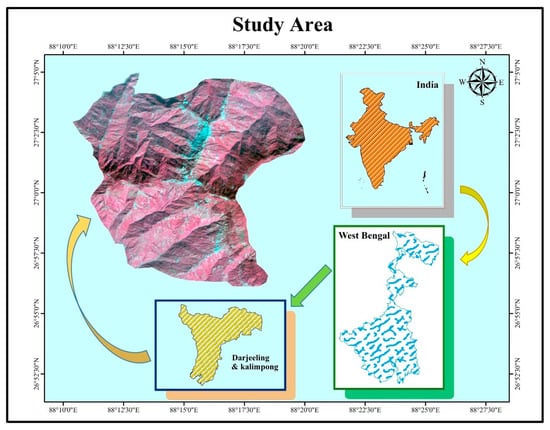
Figure 1.
The study area shows a part of the Darjeeling district.
2.2. Datasets Used
Thematic layers significant to the causative factors presented in Table 1 were prepared using various remotely sensed data from multiple sources. The GIS software (ArcGIS 10.4) was used for preparing layers such as slope, aspect, drainage density, and lineament density from ALOS PALSAR DEM. The soil and geomorphology maps of West Bengal were collected from the National Bureau of Soil Survey and Land Use Planning (NBSS and LUP), Government of India. A geology map was compiled from the Geological Survey of India (GSI). The Catrosat-2 series (MX) dataset generated a land use and land cover (LULC) map. The drainage density and lineament density maps were made from the ALOS PALSAR DEM data. Data on rainfall were gathered from the Current Research Unit (CRU). The inverse distance weighting (IDW) method for interpolation was used to prepare a rainfall map. An earthquake map was prepared from the data procured from the National Centre for Seismology, New Delhi, India.

Table 1.
Data used for generating landslide conditioning factor.
2.3. Methodology
The basic methodology adopted for preparing LSM is shown in Figure 2. The initial stage of a susceptibility assessment involves gathering all available information and data about the study area. This stage is crucial as it lays the foundation for further analysis of the relationship between landslide occurrence and conditioning parameters. However, assessing the cause–effect relationships can be challenging since landslides are typically caused by multiple factors. To create a landslide susceptibility map for the Darjeeling region of West Bengal, ten inputs were chosen based on the most significant factors influencing landslides, including slope, aspect, earthquake activity, drainage density, rainfall, land use/land cover (LULC), lineament density, geology, geomorphology, and soil type [12,29]. Our study expanded upon the number of factor classes considered compared to prior research. We reviewed the literature by other authors and sought to assign non-homogeneous weights to each factor class, in contrast to the uniform weighting used in previous studies. The various layer classes are rated in the range between 0 and 9, where higher ratings represent more decisive landslide influence. After preparing the final LSM, the study area was differentiated into different susceptibility zones, such as low, high, moderate, and very high.
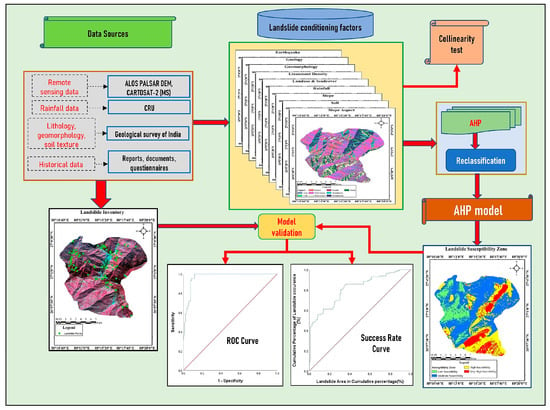
Figure 2.
Graphical representation of overall methodology of landslide susceptibility mapping.
2.4. Landslide Inventory
The position and extent of the landslide must be appropriately identified when creating the maps of landslide susceptibility. Landslide inventory is a critical component of all types of landslide zoning classification, including hazard, susceptibility, and risk zoning [42]. It has to deal with the time, location, sort, amount, and travel distance of land sliding in a specific area. Different methods are available for identifying landslides. Field observations, satellite photographs, book studies for details on previous landslides, and aerial photography are a few of them [43]. The landslide inventory map was produced using a combination of visual analysis of aerial imagery, field data, and satellite photography [14]. The whole data on landslides in India were made available by the Geological Survey of India (GSI). Resampled public data from the GSI were used to create the inventory map for the study area. One hundred and fourteen landslides have been found by this study using the available data (Figure 3). Most of the landslides recorded in this area have cliffs, highways, and banks of rivers. Erosion, steep terrain, and a lack of flora are often the causes of landslides along cliffsides.
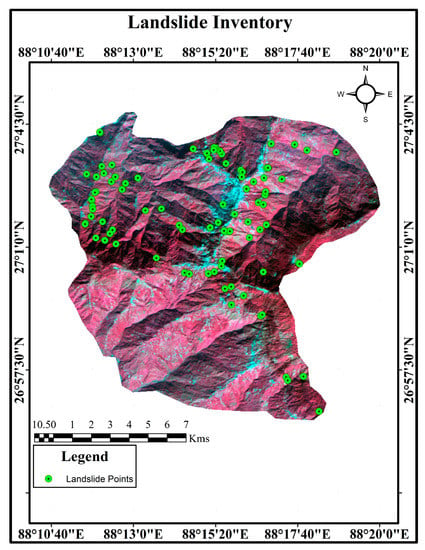
Figure 3.
Map of landslide inventory of study area.
2.5. Landslide Conditioning Factor (LCF)
2.5.1. Slope
The slope is one of the triggering factors for landslides in any hilly region. Steeper slopes are more hazard-prone to instability compared with lesser slopes. Shear stress in soil and other uncemented materials gradually rises as the slope angle increases [44,45]. In a steep slope, the gravitational force works more than in a moderate slope, though the shear stress is the same [31]. Depending on the slope angle, it is classified into five different classes with the help of a natural break classification technique: <15°, 14.6–22.45°, 22.46–29.74°, 29.75–37.88°, >37.89°. (Figure 4a). Landslides usually happen in areas with high slopes. Hence, areas with high and extremely high slopes have a higher likelihood of experiencing landslides. On the other hand, landslide incidence is more or less stable in areas with a moderate to low slope angle [46].
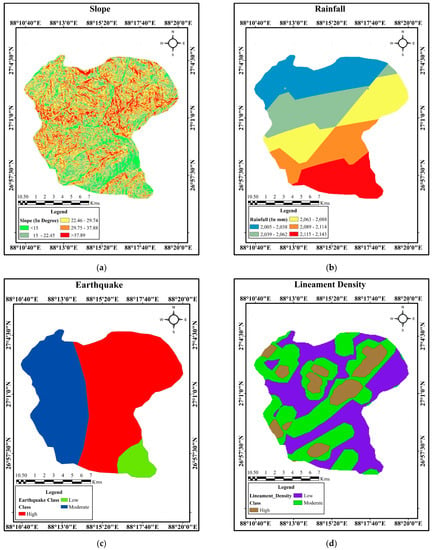
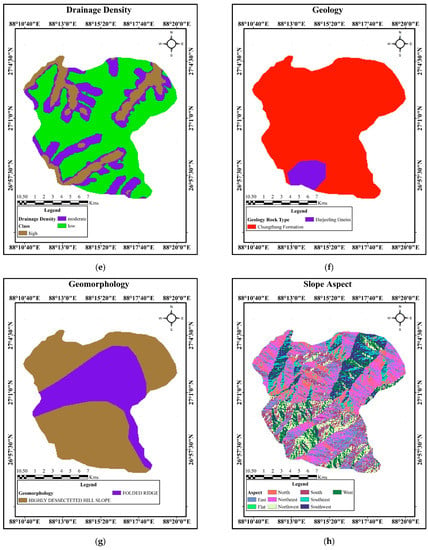
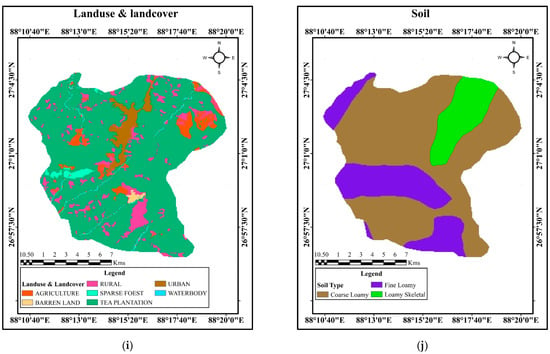
Figure 4.
Landslide conditioning factor: (a) slope, (b) rainfall, (c) earthquake, (d) lineament density, (e) drainage density, (f) geology, (g) geomorphology, (h) aspect, (i) LULC, (j) soil.
2.5.2. Rainfall
As rainfall is one of the triggering factors for landslides, May to July is the most vulnerable period [47,48]. The inverse distance weighting (IDW) method for interpolation is used to prepare a rainfall map (Figure 4b). For the rainfall map, the last ten years of data from the Darjeeling and Kalimpong areas were collected from the Climate Research Unit (CRU). The range of rainfall data are 2005–2143 mm, and are further divided into five classes: 2005–2038 mm, 2039–2062 mm, 2063–2088 mm, 2089–2114 mm, and 2115–2143 mm.
2.5.3. Earthquake
A landslide due to an earthquake can be triggered either by increased shear stress due to acceleration horizontally, or decreased strength of materials [49]. When any hilly area is seismically activated, there is potential for an earthquake to occur [49]. The Eastern Himalayas region is very active seismically. A map of earthquakes has been created using point data from the National Centre for Seismology in New Delhi, which spans more than 200 years. The earthquake map (Figure 4c) has been created using the Inverse Distance Weighted tool in a GIS environment, and is divided into three classes.
2.5.4. Lineament Density
A study of landslide density helps us to understand the causative elements of landslides [50]. From the literature, it is understood that in the Himalayan region, landslide circumstances are generally very close to the local geological lineament [50,51,52,53]. Landslides are further vulnerable in the joint, fractured, and faulted zones [28]. The thematic map lineament density (Figure 4d) was generated from ALOS PALSAR DEM images after interpretation in a GIS environment. Rectilinear inclinations of morphological features, linear stream courses, structural alignments, and tonal contrast aid in interpreting the lineaments. Despite discovering huge lineaments, no substantial thrusts or faults have been observed in the study area [12].
2.5.5. Drainage Density
Drainage density (DD) is a triggering factor for landslides, where drainage controls the landslide, and its densities correspond to the nature of geotechnical features as well as soil properties [40]. River Tista is the biggest river in the study area. Almost all streamlines initiated from high ridges flow down by making valleys and meet the Tista river. Infiltration is inversely related to drainage density [54]. Equation (1) is used to generate drainage density:
where is the measurement term of the drainage system and represents drainage basin size. The Euclidean distance approach generates drainage density maps in GIS and is classified into three classes (Figure 4e).
2.5.6. Geology
The structure and content of different geology determine the strength of the rock [14]. Compared to soft rocks, the more substantial rocks provide excellent protection from the main thrusts and are less prone to landslides [55,56]. Geological rock properties represent texture, color, grain size, or properties. The geology map (Figure 4f) was prepared using the geology of the study area published by GSI.
2.5.7. Geomorphology
Geomorphology plays a significant role in the command of landslides. Inflated altitude regions are more vulnerable to landslides than lower altitude regions. The geomorphology map (Figure 4g) was extracted from the published map from the BHUKOSH portal (https://www.bhukosh.gsi.gov.in (accessed on 31 May 2022)) in the GIS environment.
2.5.8. Aspect
The slope aspect represents the orientation of the slope angle [57]. The south-east direction is more vulnerable than the rest of the directions [56]. East- and south-facing slopes are more likely to have landslides, according to the distribution of landslides [58]. Generally, north-facing slopes have more vegetation density than south-facing slopes [40]. Due to sun rotation, in the afternoon, west-facing slopes experience the hottest time of the day [59]. The slope aspect map (Figure 4h) is classified into 1. flat, 2. north, 3. north-east, 4. east, 5. south-east, 6. south, 7. south-west, 8. west, 9. north-west, and this map was generated in the GIS platform. The slope facing south and east makes up a significant component of the study area. The west-facing slope covers the lower part of the area, while a slope angle pointing north comprises a moderate to low slope zone.
2.5.9. Land Use and Land Cover
A key element contributing to the incidence of landslides is land use and land cover. Barren regions are more prone to landslides than lush trees. Deforestation is another essential factor that causes landslides. Areas covered with vegetation have seen that the big woody trees with long root systems have helped to improve slope stability in the area. Vegetation density is inversely proportional to landslides [55]. The LULC map (Figure 4i) was extracted using CARTOSAT-2 (MX) series imagery. The LULC map is organized into many categories, including rural and urban areas, sparse forests, tea plantations, agricultural land, barren land, and waterbodies. The southern portion of the area is where you will find agricultural land and developed regions with excellent road access. The bulk of the basin is covered in forest. In the southern zone, human intervention is more common than in the northern region, owing to accessibility issues.
2.5.10. Soil
The occurrence of landslides impacts topsoil cover on a slope. Regarding soil texture, rocky and sandy loam have higher landslide potential than silt loam, fine sandy loam, gravelly silt loam, and loam [22,60]. The soil map (Figure 4j) for the study area was created from a local soil map made by NBSS and LUP data on a scale of 1:500,000. Three different textural groups: fine loamy, coarse loamy, and loamy soil skeletal, are found in this region.
2.6. Method
2.6.1. Analytical Hierarchy Process (AHP)
The multi-criteria decision analysis (MCDA) method, AHP, is a systematic way to arrange and evaluate difficult mathematical choices. Since then, it has undergone substantial research and development. The factors affecting landslide susceptibility must be added while creating the susceptibility map. The layers have been weighted for this based on their significance. In AHP, the pair-wise comparison matrix method is implemented for the MCDM structure. Qualitative (subjective) and quantitative (objective) decision-making analysis is performed using the AHP method. The number of columns and rows in the comparison matrix is equal, where value 1 is placed on the diagonal of the matrix, and one side of the diagonal stores the scores. Each layer must rate against the other to construct a pair-wise confusion matrix. The rating value ranges from 1 to 9 (Table 2). Each pair-wise comparison matrix value represents the importance of two factors. It was thought that if attribute A is given a score of 9, meaning it is more important than attribute B, then B must receive a score of 1/9, meaning it is less important than A.

Table 2.
The scale of weightage for AHP given by Saaty [63].
The consistency ratio (CR) and consistency index (CI) need to be calculated to validate the pair-wise comparison matrix [36,61,62]. We need to know the value of the 1970 Saaty-projected random consistency index (RI) (Table 3) to compute the CR [59]. If the value of CR < 0.10, we will accept the pair-wise comparison matrix. The following formula used for calculating CI and CR [63]:

Table 3.
RI value for calculating CR by Saaty [63].
The principle eigenvalue is and n is the number of factors.
2.6.2. Multi-Collinearity Analysis of LFC
In the least squares regression analysis, the variance inflation factor (VIF) is used to assess the level of multi-collinearity. The exponent shows the multicollinearity-based increases in the coefficient [64]. The amount of multi-collinearity may be evaluated using the VIF’s value. An observational rule states that multi-collinearity is high if the VIF value exceeds 5. The second approach to investigating multi-collinearity uses the tolerance (T) margin of error. Tolerance is a comparatively universal kind of multiple correlation coefficient [65]. Fully multi-collinear variables have no margin of error since they are entirely predictable from all independent variables. If a variable’s tolerance value is one, it has zero correlation with any of the independent variables [33,65]. The criteria VIF and T revealed that the study was multi-collinear. It is shown below.
Here, is the coefficient of determination (R-squared) of the model of the descriptive variable j as the response variable, and the other explanatory variables as the independent variable.
2.6.3. Model Accuracy Evaluation Method
A range of statistical indicators may be used to evaluate the efficacy of landslide hazard zonation models. To assess the performance of the prediction model, many validation model evaluation approaches were employed in this study, including sensitivity, receiver operating characteristics (ROC), specificity, area under curve (AUC), and accuracy. The effectiveness of landslide susceptibility prediction has recently been extensively studied using the ROC_AUC technique [26,66]. The inputs used to create the ROC curve were true positive, which refers to a landslide that was correctly anticipated on the axis-“X”, and false positive, which refers to a landslide that was not correctly predicted on the axis-“Y”. The models were statistically compared using AUC, a measure of the inclusive effectiveness of the models. ROC-AUC’s accuracy is assessed as poor when the value is between 0.5 and 0.6, moderate when the value is between 0.6 and 0.7, high when the value is between 0.7 and 0.8, and exceptional when the value is between 0.8 and 0.9 [67]. Consequently, AUC values may be used to evaluate the accuracy of a prediction model.
The receiver operating characteristics (ROC) curve was used to assess the map and the model’s precision [38,68,69,70]. The ROC curve was shown concerning the axis-“X” and axis-“Y”, where the axis-“X” is the false positive rate (1-specificity) and the “Y” axis is the true positive rate (sensitivity) [25,31,70,71].
where TP = true positive, FP = false positive, TN = true negative, FN = false negative. A ROC curve was used for the assessment of the hazard map.
3. Result
3.1. Multi-Collinearity Analysis of LCF
Table 4 displays the findings of the multi-collinearity connection between the ten independent components employed in this investigation. The lineament density has the highest value (VIF = 1.423), according to the findings of multi-collinearity between these variables. In contrast, the land use and land cover component variance factor has the lowest value (VIF = 1.029). In addition, all variables have VIF values less than five, and all factors have high T values. Since each independent variable uniquely impacts the dependent variable, there is no multi-collinearity among the variables used in this study. Hence, with less collinearity, every layer is used to compute the final LSM map.

Table 4.
Multi-collinearity analysis of landslide conditioning factors.
3.2. Assessment with AHP for Generating Landslide Susceptibility Mapping
The LSM map was prepared by integrating all ten layers: drainage density, rainfall, lineament density, slope, geology, LULC, geomorphology, soil, aspect, and earthquake. Each sub-factor of LCF is assigned weights for generating LSM [72]. Table 5 represents the weights of each sub-factor of LCFs. LSM is created by the AHP method in the GIS environment with ten selected LCFs by the formula
where l are the individual layers, w are their corresponding weights, and n is the number of layers (Table 6).

Table 5.
LSM weights and rating system of different landslide conditioning factors.

Table 6.
The final pair-wise comparison matrix of landslide conditioning factors.
From the outcome of the AHP model, the results were utilized to generate the final LSM and classified into low susceptibility, moderate susceptibility, high susceptibility, and very high susceptibility zones (Figure 5). Susceptibility mapping for the study area shows that the very high susceptibility zone covers 14.40% (19.312 km2), the high susceptibility zone covers 32.20% (43.180 km2), and the moderate susceptibility zone covers 36.77% (49.321 km2). The low susceptibility zone covers 16.63% (22.303 km2) of the total area. So, we observed that 83.37% of the total area comes under the moderate to very high zone.

Figure 5.
Final landslide susceptibility map of the part of the Darjeeling district.
3.3. Validation of LSM and Comparison with Field Data
AHP prepares an LSM of the study area. The AUC curve is drawn using a validating dataset. The dataset is divided into training (70%) and testing (30%) datasets. The testing dataset is used for the validation procedure. The AUC value obtained for this study region is 96.8%. An acceptable model has an AUC value from 0.70 to 0.8, a good hazard model has an AUC from 0.8 to 0.9, and an outstanding model has an AUC greater than 0.9. Our findings show that our model had an AUC of 96.8% (Figure 6), suggesting an extradentary model for susceptibility and functioning [57].
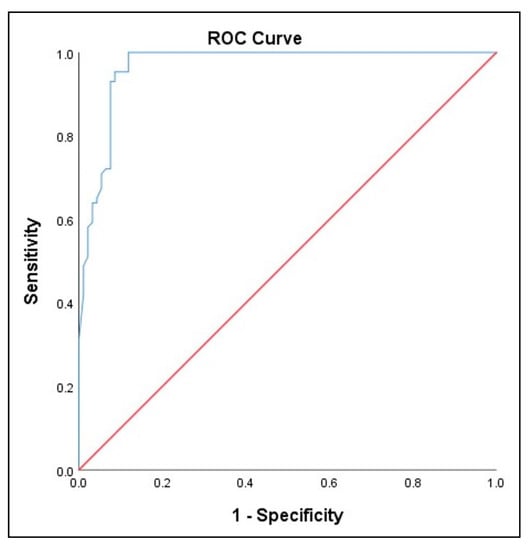
Figure 6.
Overall model’s accuracy is represented in AUC-ROC curve.
To evaluate the accuracy of a predictive model, it is important to compare the model’s predictions to real-world data. In the case of a landslide susceptibility map developed using the analytic hierarchy process (AHP) model, one method of validation is to use a success rate curve. The success rate curve is constructed by plotting the cumulative percentage of observed landslide occurrence against the cumulative percentage of the study area in decreasing the landslide susceptibility index (LSI) values [21,73]. The area under the success rate curve can be used to assess the accuracy of the prediction [53]. To validate the AHP model’s landslide susceptibility map, 30% of the data were randomly selected and used for model validation. The results of the success rate curve analysis for the AHP model showed an area under the curve of 0.813, corresponding to a prediction accuracy of 81.30% (Figure 7). The results show good accuracy of the model.
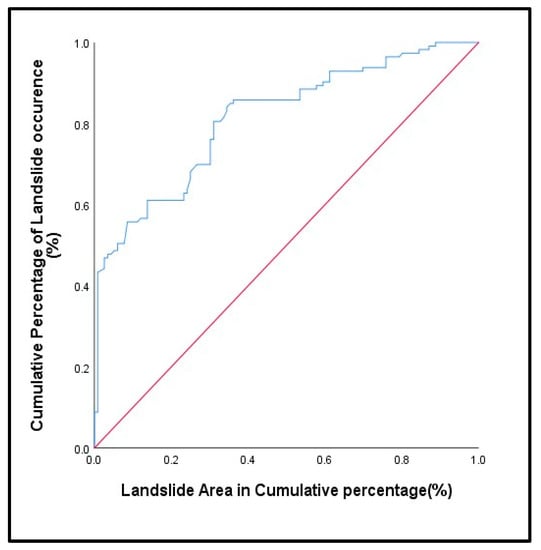
Figure 7.
Accuracy of the model represented in a success rate curve.
4. Discussion
Since hilly and mountainous areas are more vulnerable to natural dangers, planning and development must be performed cautiously. One of these dangers is the possibility of a landslide. Landslides are likely to occur under similar conditions as those observed in previous studies [74,75]. Landslide susceptibility mappings are crucial in these areas because they provide decision-makers and planners with a better understanding of the process, allowing them to take the first line of defensive action [76]. It is challenging to create an accurate LSM that can be used to designate areas prone to landslides [77]. As a consequence, several solutions are being developed daily all around the globe to handle these challenges of accuracy and reliability [78]. Due to the exhaustive research of LSM, new methodologies have been created. Our research employs MCDA algorithms to develop an accurate model of landslide hazard zonation. LCFs help to initiate landslides. It is critical to choose the appropriate LCFs when developing an accurate landslide susceptibility model. LSM models provide strong predictive capability with less inaccuracy as a consequence. There are numerous LCFs, and they vary depending on the characteristics locally and globally. These landslide indicators are linked to the land use, climatic, geological, and geomorphological variables that regulate landslides. The area’s edge is dominated by the convex slope, the middle section by the straight slope, and the bottom portion by the concave slope. There are no standards for selecting LCFs based on the variety of indicators and the characteristics of the region [79]. Much effort has been spent in choosing the most appropriate and stressful factors. The multi-collinearity test helps us to find the correlation between LCFs that may impact the overall accuracy of the models. Ten (10) LCFs were chosen as independent layers in the present research to assess the susceptibility of the area to landslides. The VIF was used to evaluate the LCFs’ multi-collinearity. Our findings show that the layers have no multi-collinearity between them. As a result, all variables were included in this model. According to the study’s results, one of the reliable approaches for LSM is AHP, which describes the weighted-overlay analysis technique with a multi-criteria decision approach. To classify the area into different susceptibility zones, ten (10) thematic layers were used, including rainfall, slope, earthquake, aspect, lithology, drainage density, lineament density, LULC, soil, and geomorphology. Figure 5 depicts a statistically generated landslide susceptibility map interpreted using the landslide hazard index (LHI) value. The model’s min and max LHI values were 1393 and 5391, respectively, with a mean of 2606.88 and a standard deviation (s.d.) of 584.93 (Figure 8). Since this histogram showed that the values were unevenly distributed, the natural-break categorization approach was employed for zonation mapping [80]. As a result, four landslide hazard zones were identified and mapped: low susceptibility, moderate susceptibility, high susceptibility, and extremely high susceptibility (Figure 5). The analytical area % of the extremely high susceptibility zone for AHP is 11.68. (Figure 9). According to the hazard area, AHP falls within the high to extremely high zone with 37.86 percent (Figure 10). As a result, we may assume that the whole study area is in the high-risk zone. The AHP methodology is widely used in landslide susceptibility mapping. However, it has some limitations in the context of the selected area. One limitation of using AHP methodology for landslide susceptibility mapping in Darjeeling is that it relies heavily on expert opinion, which may be subjective and may vary from person to person. The quality and availability of data can also impact the accuracy of the AHP model, especially in areas where data are limited. Another limitation of AHP methodology for landslide susceptibility mapping in Darjeeling is that it requires extensive data inputs, which can be challenging to obtain and verify in remote and mountainous regions. The AHP method assumes that the weights assigned to each criterion remain constant over time, which may not be the case in dynamic and rapidly changing environments such as Darjeeling. The AHP method does not consider the temporal and spatial variability of landslide triggering factors, which can vary significantly depending on the location and time of year. The AHP method does not account for the complex interactions and feedback mechanisms between factors, which can lead to underestimating or overestimating the risk of landslides in certain areas. Moreover, the trustworthiness of the LSM map is dependent on the findings obtained from the ROC-AUC and success rate curve. The GSI’s released data were used to create a landslide inventory map. A total of 114 landslides were recorded, with 79 (70%) serving as training data and 35 (30%) serving as testing data. The AHP model generated maps with AUC values of 96.8 percent. The success rate curve was also plotted for determining the accuracy of the model, which was found to be 81.30 percent. Since time is an important factor in hazard research, this finding is useful in an emergency. One may conclude that the models’ accuracy is comparable. We recommend using the AHP model in landslide investigations because it can generate excellent and reliable landslide hazard maps for risk reduction and management planning.
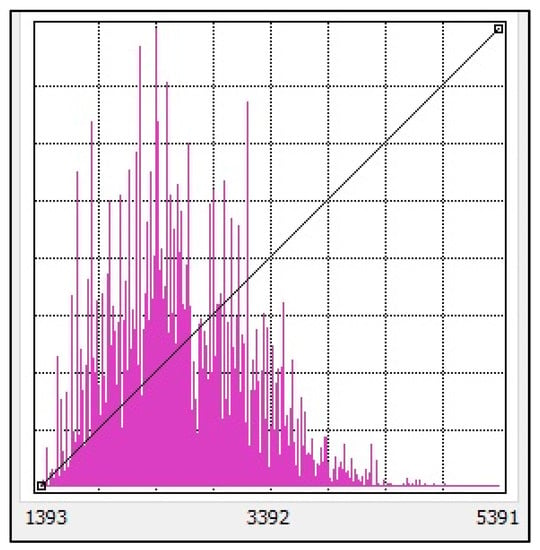
Figure 8.
Histogram analysis of the LSM model.
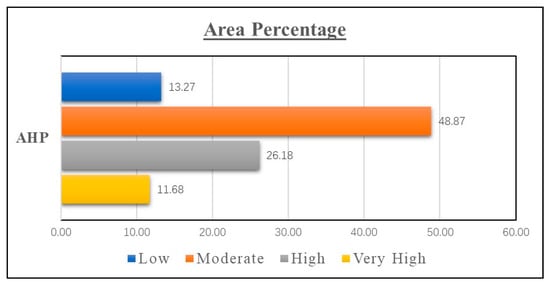
Figure 9.
The graph shows the area percentage of different landslide susceptibility classes.
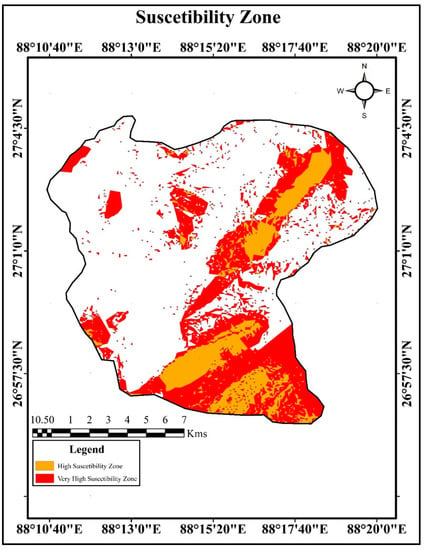
Figure 10.
The map shows the high to very high susceptibility zone of the study area.
5. Conclusions
One of the deadliest natural dangers in the mountainous terrain is a landslide. Due to man-made and natural events, the highly damaged mountainous landscape is vulnerable to landslides (such as earthquakes, climate change, and human intervention, respectively). Because of these threats, communities in West Bengal’s northern Himalayan highlands live in a never-ending nightmare, leading to socio-economic losses. To protect property and livelihood, interim and long-term solutions to reduce the risk of landslides in this region are required. To aid in infrastructural development and socio-economic development planning, we must identify and map the most vulnerable areas. LSM may be a critical tool for assessing risk management in rugged terrain. For many years, the application of MCDA models for landslide hazard assessment has produced amazingly efficient and exact results. The primary goal of this study is to evaluate the efficacy of MCDA models AHP and to determine the most accurate and helpful approach for detecting landslide-prone places in the research region. The result is based on AHP, classified into four landslide susceptibility classes. The classes are very high, high, moderate, and low landslide susceptibility. The results show that 26.18% of the total area falls under high landslide susceptibility zones, and 11.68% falls into very high susceptibility areas. So, the entire 37.86% area is in a high to very high susceptibility zone. Our findings (based on LSM and AUC) show that the usual strategy is successful. The AHP MCDA algorithm achieved 96.8 percent for the AUC-ROC curve and 81.3 percent for the success rate curve. From the result, we can identify that most areas which fall under the high to very high susceptibility classes are in the eastern, south-eastern, and southern parts of the area. The pattern of landslide sites reveals that landslides often occur on heavily dissected slopes. Less debris-filled vegetation areas can increase the risk of landslides. The area’s combined landslip categorization is debris slide. Hence, it can be concluded that the most likely place for a landslide to occur in this study area is a severely dissected hill with debris and low to moderate vegetation, usually sparse forest, barren land, or a tea plantation area. This research successfully identified the landslide-prone locations, and the best location for planners for development in the hilly region of Darjeeling, West Bengal, India. Finally, the LSM established in this research may be used by decision-makers, land-use planners, and other governmental and non-governmental entities as an efficient tool for optimizing resource management, infrastructure development, and human activity in the studied area.
Author Contributions
Conceptualization, A.S.; methodology, A.S., V.G.K.V. and A.B.; software, A.S.; validation, A.S., V.G.K.V. and A.B.; formal analysis, A.S.; investigation, A.S., V.G.K.V., A.B. and S.K.; resources, A.S., V.G.K.V. and A.B.; writing—original draft preparation, A.S.; writing—review and editing, A.S., V.G.K.V., A.B. and S.K.; visualization, A.S., V.G.K.V., A.B. and S.K.; supervision, V.G.K.V. and A.B. All authors have read and agreed to the published version of the manuscript.
Funding
This research received no external funding.
Acknowledgments
The authors are thankful to the Department of Mining Engineering, Indian Institute of Technology (Indian School of Mines), Dhanbad, for providing an adequate environment for the research work. Authors thanks Lakshya Tripathi for the support during the study.
Conflicts of Interest
The authors declare no conflict of interest.
References
- Shano, L.; Raghuvanshi, T.K.; Meten, M. Landslide susceptibility evaluation and hazard zonation techniques—A review. Geoenvironmental Disasters 2020, 7, 18. [Google Scholar] [CrossRef]
- Kalantar, B.; Ueda, N.; Saeidi, V.; Ahmadi, K.; Halin, A.A.; Shabani, F. Landslide Susceptibility Mapping: Machine and Ensemble Learning Based on Remote Sensing Big Data. Remote Sens. 2020, 12, 1737. [Google Scholar] [CrossRef]
- Karagianni, A.; Lazos, I.; Chatzipetros, A. Remote sensing techniques in disaster management: Amynteon mine landslides, Greece. In Intelligent Systems for Crisis Management: Gi4DM 2018, 1st ed.; Springer: Berlin/Heidelberg, Germany, 2019; pp. 209–235. [Google Scholar]
- Liu, P.; Wei, Y.; Wang, Q.; Chen, Y.; Xie, J. Research on Post-Earthquake Landslide Extraction Algorithm Based on Improved U-Net Model. Remote Sens. 2020, 12, 894. [Google Scholar] [CrossRef]
- Huang, F.; Yin, K.; Huang, J.; Gui, L.; Wang, P. Landslide susceptibility mapping based on self-organizing-map network and extreme learning machine. Eng. Geol. 2017, 223, 11–22. [Google Scholar] [CrossRef]
- Lagomarsino, D.; Tofani, V.; Segoni, S.; Catani, F.; Casagli, N. A Tool for Classification and Regression Using Random Forest Methodology: Applications to Landslide Susceptibility Mapping and Soil Thickness Modeling. Environ. Model. Assess. 2017, 22, 201–214. [Google Scholar] [CrossRef]
- Legorreta Paulín, G.; Bursik, M.; Hubp, J.L.; Mejía, L.M.P.; Aceves Quesada, F. A GIS method for landslide inventory and susceptibility mapping in the Río El Estado watershed, Pico de Orizaba volcano, México. Nat. Hazards 2014, 71, 229–241. [Google Scholar] [CrossRef]
- Shirzadi, A.; Bui, D.T.; Pham, B.T.; Solaimani, K.; Chapi, K.; Kavian, A.; Shahabi, H.; Revhaug, I. Shallow landslide susceptibility assessment using a novel hybrid intelligence approach. Environ. Earth Sci. 2017, 76, 60. [Google Scholar] [CrossRef]
- Tsangaratos, P.; Ilia, I.; Hong, H.; Chen, W.; Xu, C. Applying Information Theory and GIS-based quantitative methods to produce landslide susceptibility maps in Nancheng County, China. Landslides 2017, 14, 1091–1111. [Google Scholar] [CrossRef]
- Pham, B.T.; Jaafari, A.; Prakash, I.; Bui, D.T. A novel hybrid intelligent model of support vector machines and the MultiBoost ensemble for landslide susceptibility modeling. Bull. Eng. Geol. Environ. 2019, 78, 2865–2886. [Google Scholar] [CrossRef]
- Wang, H.; Zhang, L.; Yin, K.; Luo, H.; Li, J. Landslide identification using machine learning. Geosci. Front. 2020, 12, 351–364. [Google Scholar] [CrossRef]
- Saha, A.; Villuri, V.G.K.; Bhardwaj, A. Development and Assessment of GIS-Based Landslide Susceptibility Mapping Models Using ANN, Fuzzy-AHP, and MCDA in Darjeeling Himalayas, West Bengal, India. Land 2022, 11, 1711. [Google Scholar] [CrossRef]
- Zhang, S.; Bai, L.; Li, Y.; Li, W.; Xie, M. Comparing Convolutional Neural Network and Machine Learning Models in Landslide Susceptibility Mapping: A Case Study in Wenchuan County. Front. Environ. Sci. 2022, 10, 886841. [Google Scholar] [CrossRef]
- Selamat, S.N.; Majid, N.A.; Taha, M.R.; Osman, A. Landslide Susceptibility Model Using Artificial Neural Network (ANN) Approach in Langat River Basin, Selangor, Malaysia. Land 2022, 11, 833. [Google Scholar] [CrossRef]
- Merghadi, A.; Yunus, A.P.; Dou, J.; Whiteley, J.; Thaipham, B.; Bui, D.T.; Avtar, R.; Abderrahmane, B. Machine learning methods for landslide susceptibility studies: A comparative overview of algorithm performance. Earth Sci. Rev. 2020, 207, 103225. [Google Scholar] [CrossRef]
- Dikshit, A.; Satyam, D.N.; Towhata, I. Early warning system using tilt sensors in Chibo, Kalimpong, Darjeeling Himalayas, India. Nat. Hazards 2018, 94, 727–741. [Google Scholar] [CrossRef]
- Borgatti, L.; Soldati, M. Landslides as a geomorphological proxy for climate change: A record from the Dolomites (northern Italy). Geomorphology 2010, 120, 56–64. [Google Scholar] [CrossRef]
- Aleotti, P.; Chowdhury, R. Landslide hazard assessment: Summary review and new perspectives. Bull. Eng. Geol. Environ. 1999, 58, 21–44. [Google Scholar] [CrossRef]
- Mallick, J.; Singh, R.K.; AlAwadh, M.A.; Islam, S.; Khan, R.A.; Qureshi, M.N. GIS-based landslide susceptibility evaluation using fuzzy-AHP multi-criteria decision-making techniques in the Abha Watershed, Saudi Arabia. Environ. Earth Sci. 2018, 77, 276. [Google Scholar] [CrossRef]
- Kanwal, S.; Atif, S.; Shafiq, M. GIS based landslide susceptibility mapping of northern areas of Pakistan, a case study of Shigar and Shyok Basins. Geomat. Nat. Hazards Risk 2017, 8, 348–366. [Google Scholar] [CrossRef]
- Das, S.; Sarkar, S.; Kanungo, D.P. GIS-based landslide susceptibility zonation mapping using the analytic hierarchy process (AHP) method in parts of Kalimpong Region of Darjeeling Himalaya. Environ. Monit. Assess. 2022, 194, 234. [Google Scholar] [CrossRef]
- Anbalagan, R.; Kumar, R.; Parida, S.; Lakshmanan, K. GIS Based Post Earthquake Landslide Hazard Zonation Mapping of Lachung Basin, Sikkim. Int. J. Emerg. Technol. Adv. Eng. 2014, 4, 431–441. [Google Scholar]
- Saha, A.; Villuri, V.G.K.; Bhardwaj, A. Assessment and preparation of landslide susceptibility zonation map by geospatial method using remote sensing and GIS. In Proceedings of the ACRS 2020—41st Asian Conference on Remote Sensing, Deqing, China, 9–11 November 2020; Volume 1–3, pp. 461–470. [Google Scholar]
- Sarma, C.P.; Dey, A.; Krishna, A.M. Influence of digital elevation models on the simulation of rainfall-induced landslides in the hillslopes of Guwahati, India. Eng. Geol. 2020, 268, 105523. [Google Scholar] [CrossRef]
- Huang, W.; Ding, M.; Li, Z.; Zhuang, J.; Yang, J.; Li, X.; Meng, L.; Zhang, H.; Dong, Y. An Efficient User-Friendly Integration Tool for Landslide Susceptibility Mapping Based on Support Vector Machines: SVM-LSM Toolbox. Remote Sens. 2022, 14, 3408. [Google Scholar] [CrossRef]
- Zhao, P.; Masoumi, Z.; Kalantari, M.; Aflaki, M.; Mansourian, A. A GIS-Based Landslide Susceptibility Mapping and Variable Importance Analysis Using Artificial Intelligent Training-Based Methods. Remote Sens. 2022, 14, 211. [Google Scholar] [CrossRef]
- Pal, S.C.; Das, B.; Malik, S. Potential Landslide Vulnerability Zonation Using Integrated Analytic Hierarchy Process and GIS Technique of Upper Rangit Catchment Area, West Sikkim, India. J. Indian Soc. Remote Sens. 2019, 47, 1643–1655. [Google Scholar] [CrossRef]
- Basu, T.; Pal, S. RS-GIS based morphometrical and geological multi-criteria approach to the landslide susceptibility mapping in Gish River Basin, West Bengal, India. Adv. Space Res. 2019, 63, 1253–1269. [Google Scholar] [CrossRef]
- Yunis, C.R.C.; López, R.S.; Cruz, S.M.O.; Castillo, E.B.; López, J.O.S.; Trigoso, D.I.; Briceño, N.B.R. Land Suitability for Sustainable Aquaculture of Rainbow Trout (Oncorhynchus mykiss) in Molinopampa (Peru) Based on RS, GIS, and AHP. ISPRS Int. J. Geo-Inf. 2020, 9, 28. [Google Scholar] [CrossRef]
- Ma, J.; Liu, X.; Niu, X.; Wang, Y.; Wen, T. Forecasting of Landslide Displacement Using a Probability-Scheme Combination Ensemble Prediction Technique. Int. J. Environ. Res. Public Health 2020, 17, 4788. [Google Scholar] [CrossRef] [PubMed]
- Ahmed, B. Landslide susceptibility mapping using multi-criteria evaluation techniques in Chittagong Metropolitan Area, Bangladesh. Landslides 2015, 12, 1077–1095. [Google Scholar] [CrossRef]
- Calligaris, C.; Poretti, G.; Tariq, S.; Melis, M.T. First steps towards a landslide inventory map of the Central Karakoram National Park. Eur. J. Remote Sens. 2013, 46, 272–287. [Google Scholar] [CrossRef]
- Arabameri, A.; Pradhan, B.; Rezaei, K.; Lee, S.; Sohrabi, M. An ensemble model for landslide susceptibility mapping in a forested area. Geocarto Int. 2020, 35, 1680–1705. [Google Scholar] [CrossRef]
- Arabameri, A.; Rezaei, K.; Cerda, A.; Lombardo, L.; Rodrigo-Comino, J. GIS-based groundwater potential mapping in Shahroud plain, Iran. A comparison among statistical (bivariate and multivariate), data mining and MCDM approaches. Sci. Total Environ. 2019, 658, 160–177. [Google Scholar] [CrossRef] [PubMed]
- Mahalingam, R.; Olsen, M.J. Evaluation of the influence of source and spatial resolution of DEMs on derivative products used in landslide mapping. Geomat. Nat. Hazards Risk 2016, 7, 1835–1855. [Google Scholar] [CrossRef]
- Feizizadeh, B.; Blaschke, T. GIS-multicriteria decision analysis for landslide susceptibility mapping: Comparing three methods for the Urmia lake basin, Iran. Nat. Hazards 2013, 65, 2105–2128. [Google Scholar] [CrossRef]
- Radwan, F.; Alazba, A.A.; Mossad, A. Flood risk assessment and mapping using AHP in arid and semiarid regions. Acta Geophys. 2019, 67, 215–229. [Google Scholar] [CrossRef]
- Arabameri, A.; Pradhan, B.; Rezaei, K.; Conoscenti, C. Gully erosion susceptibility mapping using GIS-based multi-criteria decision analysis techniques. Catena 2019, 180, 282–297. [Google Scholar] [CrossRef]
- Rawat, A.; Kumar, D.; Chatterjee, R.S.; Kumar, H. A GIS-based liquefaction susceptibility mapping utilising the morphotectonic analysis to highlight potential hazard zones in the East Ganga plain. Environ. Earth Sci. 2022, 81, 358. [Google Scholar] [CrossRef]
- Singh, P.; Gupta, A.; Singh, M. Hydrological inferences from watershed analysis for water resource management using remote sensing and GIS techniques. Egypt. J. Remote Sens. Space Sci. 2014, 17, 111–121. [Google Scholar] [CrossRef]
- Ghosh, S.; van Westen, C.J.; Carranza, E.J.M.; Jetten, V.G.; Cardinali, M.; Rossi, M.; Guzzetti, F. Generating event-based landslide maps in a data-scarce Himalayan environment for estimating temporal and magnitude probabilities. Eng. Geol. 2012, 128, 49–62. [Google Scholar] [CrossRef]
- Varnes, D.J. Landslide Hazard Zonation: A Review of Principles and Practice; Amazon: Charlotte, NC, USA, 1984. [Google Scholar]
- Fell, R.; Whitt, G.; Miner, T.; Flentje, P. Guidelines for landslide susceptibility, hazard and risk zoning for land use planning. Eng. Geol. 2008, 102, 83–84. [Google Scholar]
- Achour, Y.; Boumezbeur, A.; Hadji, R.; Chouabbi, A.; Cavaleiro, V.; Bendaoud, E.A. Landslide susceptibility mapping using analytic hierarchy process and information value methods along a highway road section in Constantine, Algeria. Arab. J. Geosci. 2017, 10, 194. [Google Scholar] [CrossRef]
- Roy, J.; Saha, S. Landslide susceptibility mapping using knowledge driven statistical models in Darjeeling District, West Bengal, India. Geoenvironmental Disasters 2019, 6, 11. [Google Scholar] [CrossRef]
- Tanyaş, H.; van Westen, C.J.; Allstadt, K.E.; Jibson, R.W. Factors controlling landslide frequency–area distributions. Earth Surf. Process Landforms 2019, 44, 900–917. [Google Scholar] [CrossRef]
- Chikalamo, E.E.; Mavrouli, O.C.; Ettema, J.; van Westen, C.J.; Muntohar, A.S.; Mustofa, A. Satellite-derived rainfall thresholds for landslide early warning in Bogowonto Catchment, Central Java, Indonesia. Int. J. Appl. Earth Obs. Geoinf. 2020, 89, 102093. [Google Scholar] [CrossRef]
- Sengupta, A.; Gupta, S.; Anbarasu, K. Rainfall thresholds for the initiation of landslide at Lanta Khola in north Sikkim, India. Nat. Hazards 2010, 52, 31–42. [Google Scholar] [CrossRef]
- Farooq Ahmed, M.; Rogers, J.D.; Ismail, E.H. A regional level preliminary landslide susceptibility study of the upper Indus river basin. Eur. J. Remote Sens. 2014, 47, 343–373. [Google Scholar] [CrossRef]
- Ramli, M.F.; Yusof, N.; Yusoff, M.K.; Juahir, H.; Shafri, H.Z.M. Lineament mapping and its application in landslide hazard assessment: A review. Bull. Eng. Geol. Environ. 2010, 69, 215–233. [Google Scholar] [CrossRef]
- Mathew, J.; Jha, V.K.; Rawat, G.S. Application of binary logistic regression analysis and its validation for landslide susceptibility mapping in part of Garhwal Himalaya, India. Int. J. Remote Sens. 2007, 28, 2257–2275. [Google Scholar] [CrossRef]
- Salui, C.L. Methodological Validation for Automated Lineament Extraction by LINE Method in PCI Geomatica and MATLAB based Hough Transformation. J. Geol. Soc. India 2018, 92, 321–328. [Google Scholar] [CrossRef]
- Kumar, A.; Sharma, R.K.; Bansal, V.K. GIS-based comparative study of information value and frequency ratio method for landslide hazard zonation in a part of mid-Himalaya in Himachal Pradesh. Innov. Infrastruct. Solut. 2019, 4, 28. [Google Scholar] [CrossRef]
- Bera, A.; Mukhopadhyay, B.; Das, D. Morphometric Analysis of Adula River Basin in Maharashtra, India using GIS and Remote Sensing techniques. Geo-Spat. Data Nat. Resour. 2018, 2018, 13–35. [Google Scholar] [CrossRef]
- Kanungo, D.P.; Arora, M.K.; Sarkar, S.; Gupta, R.P. A comparative study of conventional, ANN black box, fuzzy and combined neural and fuzzy weighting procedures for landslide susceptibility zonation in Darjeeling Himalayas. Eng. Geol. 2006, 85, 347–366. [Google Scholar] [CrossRef]
- Sarkar, S.; Roy, A.K.; Martha, T.R. Landslide susceptibility assessment using Information Value Method in parts of the Darjeeling Himalayas. J. Geol. Soc. India 2013, 82, 351–362. [Google Scholar] [CrossRef]
- Youssef, A.M.; Pradhan, B.; Dikshit, A.; Al-Katheri, M.M.; Matar, S.S.; Mahdi, A.M. Landslide susceptibility mapping using CNN-1D and 2D deep learning algorithms: Comparison of their performance at Asir Region, KSA. Bull. Eng. Geol. Environ. 2022, 81, 165. [Google Scholar] [CrossRef]
- Dhakal, A.S.; Amada, T.; Aniya, M. Landslide hazard mapping and its evaluation using GIS: An investigation of sampling schemes for a grid-cell based quantitative method. Photogramm. Eng. Remote Sens. 2000, 66, 981–989. [Google Scholar]
- Bera, A.; Mukhopadhyay, B.P.; Das, D. Landslide hazard zonation mapping using multi-criteria analysis with the help of GIS techniques: A case study from Eastern Himalayas, Namchi, South Sikkim. Nat. Hazards 2019, 96, 935–959. [Google Scholar] [CrossRef]
- Lee, S.; Hong, S.-M.; Jung, H.-S. A Support Vector Machine for Landslide Susceptibility Mapping in Gangwon Province, Korea. Sustainability 2017, 9, 48. [Google Scholar] [CrossRef]
- Chen, Y.; Khan, S.; Paydar, Z. To retire or expand? A fuzzy GIS-based spatial multi-criteria evaluation framework for irrigated agriculture. Irrig. Drain. 2010, 59, 174–188. [Google Scholar] [CrossRef]
- Kolat, C.; Ulusay, R.; Suzen, M.L. Development of geotechnical microzonation model for Yenisehir (Bursa, Turkey) located at a seismically active region. Eng. Geol. 2012, 127, 36–53. [Google Scholar] [CrossRef]
- Wind, Y.; Saaty, T.L. Marketing applications of the analytic hierarchy process. Manag. Sci. 1980, 26, 641–658. [Google Scholar] [CrossRef]
- Arabameri, A.; Pradhan, B.; Rezaei, K. Gully erosion zonation mapping using integrated geographically weighted regression with certainty factor and random forest models in GIS. J. Environ. Manag. 2019, 232, 928–942. [Google Scholar] [CrossRef]
- Arabameri, A.; Pradhan, B.; Rezaei, K.; Sohrabi, M.; Kalantari, Z. GIS-based landslide susceptibility mapping using numerical risk factor bivariate model and its ensemble with linear multivariate regression and boosted regression tree algorithms. J. Mt. Sci. 2019, 16, 595–618. [Google Scholar] [CrossRef]
- Sengupta, A.; Nath, S.K. GIS-Based Landslide Susceptibility Mapping in Eastern Boundary Zone of Northeast India in Compliance with Indo-Burmese Subduction Tectonics. In Geospatial Technology for Environmental Hazards; Springer: Berlin/Heidelberg, Germany, 2022; Volume 1, pp. 19–37. [Google Scholar] [CrossRef]
- Tien Bui, D.; Tuan, T.A.; Klempe, H.; Pradhan, B.; Revhaug, I. Spatial prediction models for shallow landslide hazards: A comparative assessment of the efficacy of support vector machines, artificial neural networks, kernel logistic regression, and logistic model tree. Landslides 2016, 13, 361–378. [Google Scholar] [CrossRef]
- Anbalagan, R.; Kumar, R.; Lakshmanan, K.; Parida, S.; Neethu, S. Landslide hazard zonation mapping using frequency ratio and fuzzy logic approach, a case study of Lachung Valley, Sikkim. Geoenvironmental Disasters 2015, 2, 6. [Google Scholar] [CrossRef]
- Samui, P. Slope stability analysis: A support vector machine approach. Environ. Geol. 2008, 56, 255–267. [Google Scholar] [CrossRef]
- Avand, M.; Moradi, H.; Lasboyee, M.R. Spatial modeling of flood probability using geo-environmental variables and machine learning models, case study: Tajan watershed, Iran. Adv. Space Res. 2021, 67, 3169–3186. [Google Scholar] [CrossRef]
- Youssef, A.M.; Pradhan, B.; Dikshit, A.; Mahdi, A.M. Comparative study of convolutional neural network (CNN) and support vector machine (SVM) for flood susceptibility mapping: A case study at Ras Gharib, Red Sea, Egypt. Geocarto Int. 2022, 37, 11088–11115. [Google Scholar] [CrossRef]
- Das, S.; Sarkar, S.; Kanungo, D.P. A Critical Review on Landslide Susceptibility Zonation: Recent Trends, Techniques, and Practices in INDIAN Himalaya; Springer: Dordrecht, The Netherlands, 2023; Volume 115, ISBN 0123456789. [Google Scholar]
- Mahdadi, F.; Boumezbeur, A.; Hadji, R.; Kanungo, D.P.; Zahri, F. GIS-based landslide susceptibility assessment using statistical models: A case study from Souk Ahras province, N-E Algeria. Arab. J. Geosci. 2018, 11, 476. [Google Scholar] [CrossRef]
- Kranjčić, N.; Medak, D.; Župan, R.; Rezo, M. Support Vector Machine Accuracy Assessment for Extracting Green Urban Areas in Towns. Remote Sens. 2019, 11, 655. [Google Scholar] [CrossRef]
- Kumar, D.; Thakur, M.; Dubey, C.S.; Shukla, D.P. Landslide susceptibility mapping\& prediction using support vector machine for Mandakini River Basin, Garhwal Himalaya, India. Geomorphology 2017, 295, 115–125. [Google Scholar]
- Roccati, A.; Paliaga, G.; Luino, F.; Faccini, F.; Turconi, L. GIS-Based Landslide Susceptibility Mapping for Land Use Planning and Risk Assessment. Land 2021, 10, 162. [Google Scholar] [CrossRef]
- Mandal, K.; Saha, S.; Mandal, S. Applying deep learning and benchmark machine learning algorithms for landslide susceptibility modelling in Rorachu river basin of Sikkim Himalaya, India. Geosci. Front. 2021, 12, 101203. [Google Scholar] [CrossRef]
- Prakash, N.; Manconi, A.; Loew, S. A new strategy to map landslides with a generalized convolutional neural network. Sci. Rep. 2021, 11, 1–15. [Google Scholar] [CrossRef] [PubMed]
- Park, S.; Kim, J. Landslide Susceptibility Mapping Based on Random Forest and Boosted Regression Tree Models, and a Comparison of Their Performance. Appl. Sci. 2019, 9, 942. [Google Scholar] [CrossRef]
- Constantin, M.; Bednarik, M.; Jurchescu, M.C.; Vlaicu, M. Landslide susceptibility assessment using the bivariate statistical analysis and the index of entropy in the Sibiciu Basin (Romania). Environ. Earth Sci. 2011, 63, 397–406. [Google Scholar] [CrossRef]
Disclaimer/Publisher’s Note: The statements, opinions and data contained in all publications are solely those of the individual author(s) and contributor(s) and not of MDPI and/or the editor(s). MDPI and/or the editor(s) disclaim responsibility for any injury to people or property resulting from any ideas, methods, instructions or products referred to in the content. |
© 2023 by the authors. Licensee MDPI, Basel, Switzerland. This article is an open access article distributed under the terms and conditions of the Creative Commons Attribution (CC BY) license (https://creativecommons.org/licenses/by/4.0/).